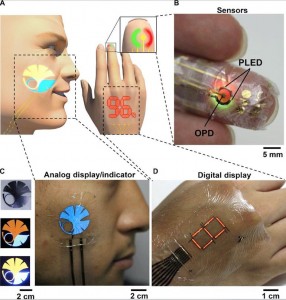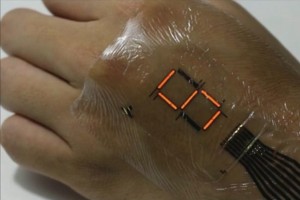

Well, thank goodness, because we should treat our body as a temple. In this case, our “temple” will have gained the prospects of photodetectors, and organically made polymer light-emitting diodes (PLEDs), good for creating the effect of energy-efficient lights. This technology has been dubbed “optoelectronic skins”, or “OE-skins”, by the genius team of Tokyo researchers that have gone to an entirely new level in field of electronic skin innovation.


Now we know some of the scientific elements of the invention. But hey, if I could guess, there’s probably a few remaining questions surrounding this entire concept- like something around the lines of “what and how are we to read via these OE-skin displays?”. The LED lights, shown in red, green, and blue, are controlled via electrical pulses, turning on and off, “mimicking pixels on a normal screen”. See the blue PLEDs in a University of Tokyo logo in the image above? These work exactly as stated, lighting up and dimming at different power levels. Same goes with the image of a hand, except in this instance, the PLEDs arrangement are situated to display more complex data. The lights on the hand are popping up in specific series of numbers and letters, “like a calculator screen on your hand”.
Pretty weird, isn’t it? Also weird is the fact that this isn’t the first attempt at flexible PLEDS (according to The Verge, who says that in 2013 “researchers made flexible PLEDs thinner than spider silk”). On the other hand, for the very first time, these OE-skins are aimed to address a previous issue of not lasting very long. These particular e-skins, containing a passivation layer of protective coating, will work to sustain lighting for several days by keeping out oxygen and water vapor, thus taking a preventative measure to stop degradation. So, if you were wondering, yes, these new LED skin “tattoos” will be worth watching for in the coming months. The research and diligence already shows that “this newest technology is the most promising to date” (Science Recorder).

 Laptop & Tablet Parts
Laptop & Tablet Parts




















